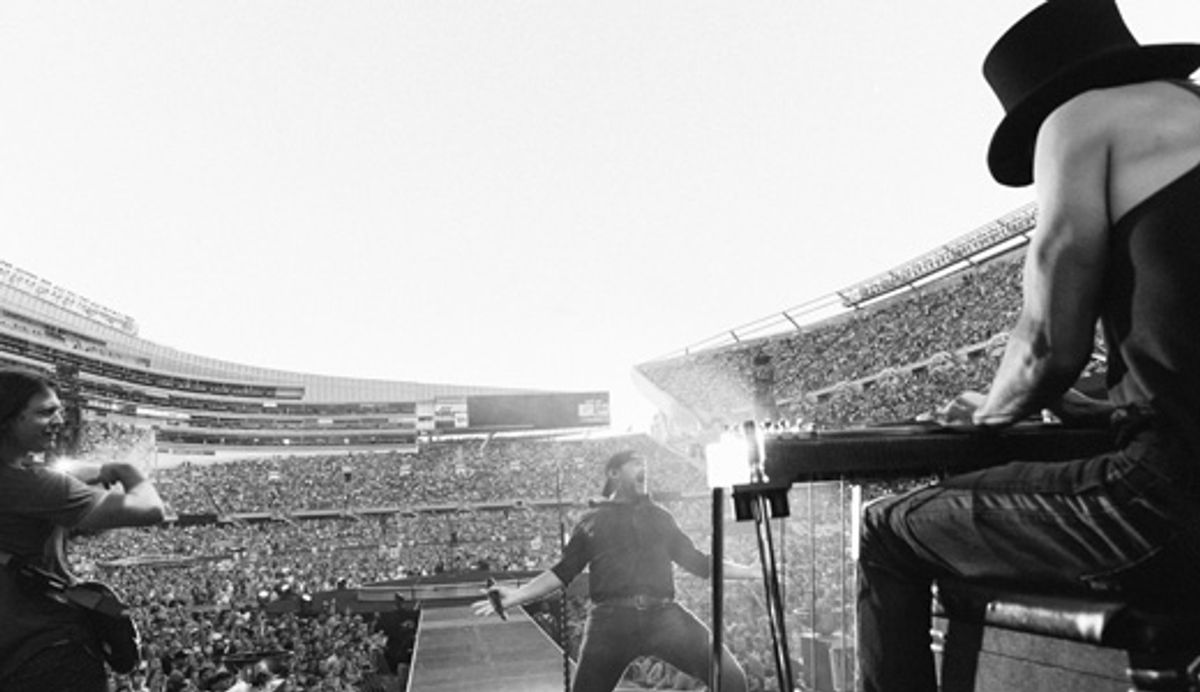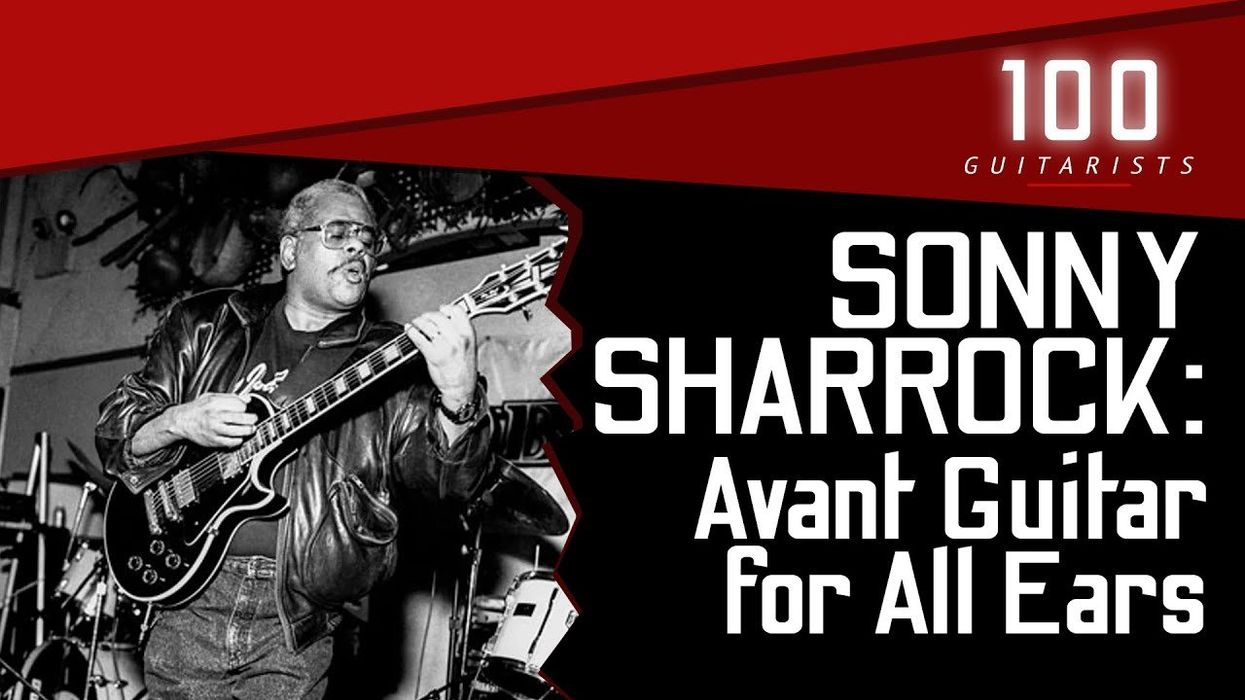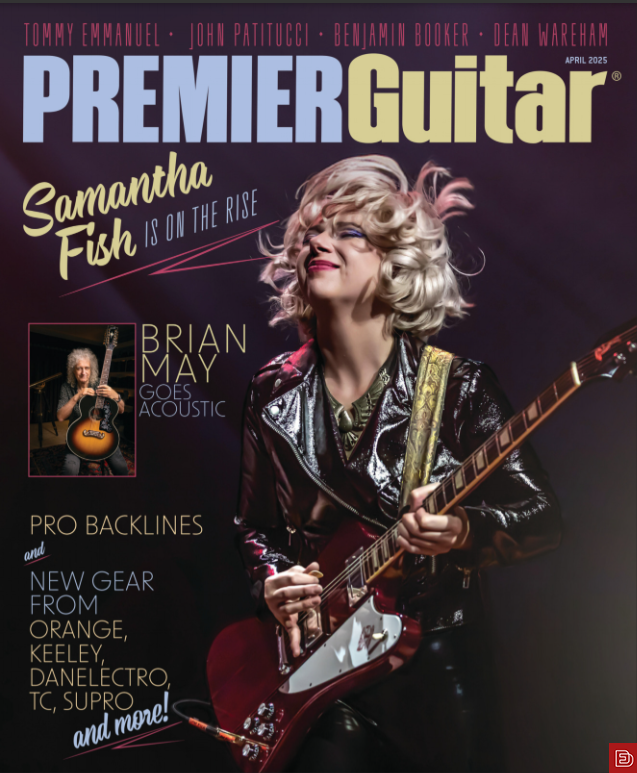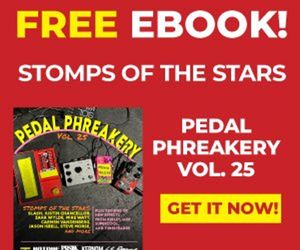
Wherever they go, there you are! With Lee Brice's band, columnist John Bohlinger (in top hat) gets to play the big joints, like Heinz Field in Pittsburgh … and then chill out in his sweatpants while Brice, center, keeps on working.
The lowdown on this sideman’s life: It’s sweet!
I've been a sideman for most of my adult life. Not surprisingly, a dozen people recommended that I Netflix Hired Gun, a documentary about musicians who play for major artists.
Hired Gun, though entertaining, earned a B-minus from me. To give you some idea of my Netflix music-doc grading scale, "A" music documentaries include:
• Anvil! The History of Anvil
• Tom Petty and the Heartbreakers: Runnin' Down a Dream
• Muscle Shoals
• The Wrecking Crew
• Searching for Sugar Man
• History of the Eagles
•Rush: Beyond the Lighted Stage
So, what's my beef with Hired Gun? It felt like one-third of the musicians interviewed saw themselves as victims, not getting a fair deal compared to the artists in front. To paraphrase their chief complaint, "One day you're a rock star on tour, living the life, checks deposited every Friday. Then suddenly, it's over and you're an anonymous schmoe with a mortgage you can't pay, while the artist you worked for remains a star."
Here's why that's nonsense. There's an expiration date on every career. That said, in the music industry, the average sideperson's shelf life is considerably longer than that of the people in front. During my quarter of a century hired-gunning it, more artists than I can remember paid me to play for them. They did all the work, had their time fighting for the spotlight, and then, for the most part, faded away. When their runs ended, somebody else took their place in the spotlight and hired me. That's the beauty of being a hired gun: When the gig is over, you take your gear and what you've learned and move on to the next artist.
The most soul-crushing struggle I ever experienced as a musician was during my two ill-fated record deals, (or, to put it more accurately, record ordeals). During deal one, I had a publishing contract that paid me enough to live on: $2,000 per month for a family of three. The publisher dropped me when the record deal ended, correctly assuming they'd wasted enough money on me.
In the music industry, the average sideperson's shelf life is considerably longer than that of the people in front.
When the second record deal rolled around, I had to take a job driving a bread truck at 5 a.m., because I had to give up hired-gun gigs to work on my own project. The label's advance money was spent on the recording. I could've gotten another pub deal, but I wanted to keep my publishing, thinking it would make me rich when the album came out. The album never came out. By the time I was dropped, I'd sold all but a few favorite guitars to survive. It was a great relief to realize that I'm not star material.
Being an artist requires real work, which does not jive with my hippie-Zen-cowboy leanings. On my current touring gig with Lee Brice, I only need to show up for a soundcheck and a show. The rest of the time, I'm playing guitar, riding my bike, exploring the city we're playing, trying to write this dumb column, and enjoying a long, pre-show siesta. My boss, Lee, works all day doing meet-and-greets, talking to radio, strategizing with management, and working on the next album and the next tour while promoting the current album and tour. After the show, I'm shoving pizza down my gullet in my sweatpants while watching Mike Judge's Tales from the Tour Bus. Lee is signing autographs or talking to program directors or promoters. He puts in 16-hour days all the time. I work two or three hours, tops. Best of all, my work isn't even work. I just play music. I wouldn't trade places with my boss for anything.
Jon Small, a film producer I worked with for six years on NBC's Nashville Star, began his career as Billy Joel's drummer in a band called the Hassles, and later, in Atilla, a duo with Joel on B3 and Small on drums. When an injury ended Jon's playing career, he took what he learned in music and turned his focus to film, where he became one of the most successful video producers of all time, producing all of Garth Brooks' work as well as groundbreaking videos for Taylor Swift, Aerosmith and Run-DMC, Keith Urban, Miranda Lambert, Janet Jackson, Billy Joel, and a long list of others. Jon gave me the best career advice ever when he said, "Never look for security in the person you're working for. You are your own security."
It's empowering to know you're the only security you need. When I hit my expiration date as a sideman on tour, TV, and recordings, I will happily transition to the small time with my own little band, schlepping my gear to play sticky-floored clubs with crap PAs and dim stages. It's liberating when your only real ambition is to play music. If you want more than music out of the music business, you're going to be disappointed.
In front, the flame burns bright and fast. On the side, it's less bright, but can burn for decades. I love being a sideman and am forever grateful to the people in front who paid me to share their stages. They did the real work. I just play. This sideman scam is the sweetest apple on the tree.
[Updated 8/5/21]
- Brent Mason: A Chameleon in Tune Town - Premier Guitar ›
- Pro Pedalboards 2021 - Premier Guitar ›
- The Codependent Guitarist: The Art of Being a Sideman - Premier ... ›
- Aerosmith and Run-DMC: For the Love of Collaboration ›
- John Bohlinger's NHL Stadium Series Experience - Premier Guitar ›
The Sunset is a fully analog, zero latency bass amplifier simulator. It features a ¼” input, XLR and ¼” outputs, gain and volume controls and extensive equalization. It’s intended to replace your bass amp both live and in the studio.
If you need a full sounding amp simulator with a lot of EQ, the Sunset is for you. It features a five band equalizer with Treble, Bass, Parametric Midrange (with frequency and level controls), Resonance (for ultra lows), and Presence (for ultra highs). All are carefully tuned for bass guitar. But don’t let that hold you back if you’re a keyboard player. Pianos and synthesizers sound great with the Sunset!
The Sunset includes Gain and master Volume controls which allow you to add compression and classic tube amp growl. It has both ¼” phone and balanced XLR outputs - which lets you use it as a high quality active direct box. Finally, the Sunset features zero latency all analog circuitry – important for the instrument most responsible for the band’s groove.
Introducing the Sunset Bass Amp Simulator
- Zero Latency bass amp simulator.
- Go direct into the PA or DAW.
- Five Band EQ:
- Treble and Bass controls.
- Parametric midrange with level and frequency controls.
- Presence control for extreme highs.
- Resonance control for extreme lows.
- Gain control to add compression and harmonics.
- Master Volume.
- XLR and 1/4" outputs.
- Full bypass.
- 9VDC, 200mA.
Artwork by Aaron Cheney
MAP price: $210 USD ($299 CAD).
PRS Guitars celebrates 40 years with the limited edition McCarty SC56. Featuring vintage-inspired design and modern innovations, this single-cutaway guitar pays tribute to Ted McCarty and his impact on the industry. With only 400 pieces available, this instrument is a must-have for collectors and performers alike.
PRS Guitars today announced the 40th Anniversary McCarty SC56 Limited Edition. With a classic PRS single-cutaway body shape and carefully chosen specifications, the McCarty SC56 is both a tribute to tradition and a reliable tool for the modern performer. Only 400 pieces will be made.
“The SC56, signifying Singlecut and 1956, model is our most recent tribute to my late mentor Ted McCarty and his impact on the guitar industry. We started with our take on a classic late ‘50s singlecut body. 1956 marks the year that Ted first had guitars made with his newly coined 'humbucker' pickups. It also happens to be the year I was born. Bringing vintage design into the modern era, we loaded this model with our McCarty III pickups, meticulously designed to deliver warm, clear, vintage tone with exceptional note separation and dynamics,” said PRS Guitars Founder & Managing General Partner, Paul Reed Smith.
Anchored by a maple top and mahogany back, the 24.594” scale length and 22-fret Pattern Vintage neck work with Phase III non-locking tuners and PRS two-piece bridge to promote its musical sustain. The PRS McCarty III pickups are controlled by a simple layout — two volume controls, two tone controls, and a three-way toggle on the upper bout.
Single-cutaway guitars are known to be heavier than their double-cutaway counterparts. The McCarty SC56 Limited Edition design incorporates weight-relief, decreasing the weight of the guitar by about 2/3 of a pound, while maintaining several points of attachment between the guitar top and back to eliminate the “hollow” sound of the cavities and promote tone transfer.
With appointments like binding on the fretboard, classic bird inlays, and a vintage-inspired nitrocellulose finish, the 40th Anniversary McCarty SC56 Limited Edition blends heritage and innovation into a timeless instrument.
PRS Guitars continues its schedule of launching new products each month in 2025.
For more information, please visit prsguitars.com.
40th Anniversary McCarty SC56 Limited Edition | Demo | PRS Guitars - YouTube
His credits include Miles Davis’ Jack Johnson and Herbie Mann—next to whom he performed in Questlove’s 2021 documentary, Summer of Soul—and his tunes have been covered by Santana and the Messthetics. But it’s as a bandleader and collaborator where Sharrock cut his wildest recordings. As groundbreaking as Sharrock’s music could be, his distorted tone and melodic tunes helped bring rock listeners into the jazz tent. Our callers let us know how much Sharrock meant to them and why he’s one of the “top guys of all time.”
Designed for players who demand flexibility without sacrificing tone, the Aquanaut fuses the rich warmth of classic analog delay with the extended range and clarity of modern digital designs. Featuring up to 600 milliseconds of delay time, the Aquanaut easily covers everything from tight slapback echoes to lush, ambient textures and rhythmic soundscapes – all with a simple, intuitive control layout.
Unlike many digital delays that can sound sterile and detached, the Aquanaut retains an organic, analog-inspired voice. Repeats are smooth and musical, gently fading into the mix to create depth and dimension without overwhelming your dry signal. Whether you’re chasing vintage tape echo, adding subtle space to your solos, or building massive atmospheric layers, the Aquanaut keeps your tone clear, present, and inspiring.
Berserker Electronics Aquanaut Delay/Echo
Key features include:
- Up to 600ms of delay time for expanded creative possibilities
- Analog-voiced digital architecture for warm, natural-sounding repeats
- Ambient-style echo that enhances, not distracts from, your core tone
- Simple, intuitive controls for delay time, feedback, and blend
The Aquanaut is available direct at www.berserkerpedals.com and Reverb at a $149 street price.






